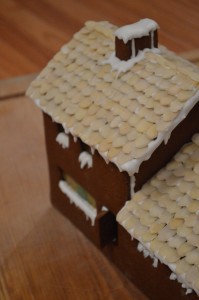 Royal icing can be used in several ways, but it is most notable as the mortar that holds gingerbread houses together. It is decorative. It’s certainly not unsafe to eat, but it is almost entirely sugar, and it sets very hard and brittle. The CIA Baking and Pastry book says it best: “not intended to be consumed, at least not in any measurable quantities.”
Royal icing can be used in several ways, but it is most notable as the mortar that holds gingerbread houses together. It is decorative. It’s certainly not unsafe to eat, but it is almost entirely sugar, and it sets very hard and brittle. The CIA Baking and Pastry book says it best: “not intended to be consumed, at least not in any measurable quantities.”
In fact besides sugar royal icing has only one other major ingredient: egg whites. It might also have cream of tartar or lemon juice, which strengthen the protein matrix created by beating the egg whites.
To make royal icing you add a small quantity of egg whites, say 3 oz, to a mixing bowl, then start whisking. Once the egg whites froth, slowly add a large quantity of icing sugar, say 16 oz. Continue to whisk until the icing is able to produce stiff peaks.
While the quantities above will yield a good, workable icing, there are some nuances of texture that can be achieved by adjusting the exact ratio of egg and sugar. For instance, in the photo of the gingerbread house above, I used a relatively high-sugar royal icing which was a bit more stiff and matted in appearance to lay the almond shingles. Then I beat in a bit more egg white to make a slightly more slack, lustrous icing that tapers to clean points for the snow and icicles.
After mixing the icing to your desired consistency it’s important to cover and properly store the mixture. Seriously think about it as cement that will set hard if left exposed to air. I transfer my icing directly to a plastic piping bag. It can be used immediately or stored in the fridge for several days. Be aware of hard bits of icing that form up the sides of the bowl and whisk. If these get reincorporated into the soft icing they could block the tip of your piping bag.
Royal Icing
Ingredients
- 3 oz egg white
- 1/4 tsp cream of tartar, or 1/2 tsp lemon juice
- 16 oz icing sugar
Procedure
- Whisk the egg whites and cream of tartar in the bowl of a stand mixer.
- Once the egg whites have become foamy, slowly add the icing sugar while continuing to whisk.
- Whisk until the icing is stiff and has a matted appearance.
- Immediately transfer icing to a piping bag or airtight container.